Banff, Alberta 作者: 来源: 发布时间:2021-12-03
I.Population and Area
-Area
Land: 4.77 km2 (1.84 sq mi)
-Population (2016)
Total: 7,847
Density: 1,646/km2 (4,260/sq mi)
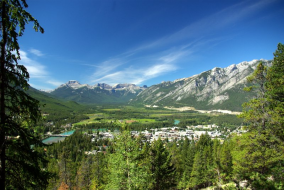
II.Natural Geography (environment and resources)
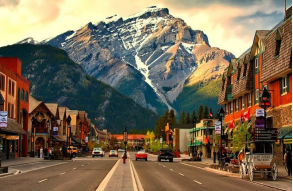
-Banff is a town within Banff National Park in Alberta, Canada. It is located in Alberta's Rockies along the Trans-Canada Highway, approximately 126 km (78 mi) west of Calgary and 58 km (36 mi) east of Lake Louise. At 1,400 to 1,630 m (4,590 to 5,350 ft) above sea level, Banff is the community with the second highest elevation in Alberta, after Lake Louise.
-The Town of Banff was the first municipality to incorporate within a Canadian national park. The town is a member of the Calgary Regional Partnership.
-Banff is a resort town and one of Canada's most popular tourist destinations. Known for its mountainous surroundings and hot springs, it is a destination for outdoor sports and features extensive hiking, biking, scrambling and skiing destinations within the area. Sunshine Village, Ski Norquay and Lake Louise Ski Resort are the three nearby ski resorts located within the national park.
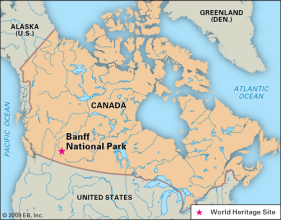
-It is surrounded by mountains, notably Mount Rundle, Sulphur Mountain, Mount Norquay, and Cascade Mountain. The town is above Bow Falls near the confluence of the Bow River and Spray River. Soils are calcareous and usually imperfectly to poorly drained in their natural state with textures from very fine sandy loam to silty clay loam.
-Transportation
In June 2008, the Banff council launched a local bus system called Roam, with three routes connecting the town, Tunnel Mountain, the Banff Springs Hotel, and the Banff Gondola. The service is operated using four hybrid Nova buses, each decorated with scenes from the National Park. There are three separate routes: • Route 1: which goes to Sulphur Mountain • Route 2: which goes to Tunnel Mountain • Route 3: which goes from Banff, to nearby Canmore. Many bus stops along the routes have screens which tell exactly how many minutes before the next two buses arrive. In December 2012, the bus system was expanded to include the Route 3 hourly service between Banff and Canmore.
Via Rail's long-distance trains no longer serve Banff, but the Banff railway station remains in use by the Rocky Mountaineer and Royal Canadian Pacific tour trains.
The nearest airport to Banff with major service is the Calgary International Airport in Calgary.
III.ECONOMY
-Average Salary in Banff, Alberta: C$50k
-The average salary in Banff, Alberta is C$50k. Trends in wages decreased by -100.0 percent in Q1 2020. The cost of living in Banff, Alberta is 100 percent higher than the national average. The most popular occupations in Banff, Alberta are General Manager, Hotel, Restaurant Assistant Manager, and Front Office Manager which pay between C$37k and C$78k per year. The most popular employers in Banff, Alberta are The Banff Centre, Fairmont, and Banff Lake Louise Tourism.
-Website: https://www.payscale.com/research/CA/Location=Banff-Alberta/Salary
IV.Industrial Characteristics
-Given the Town of Banff’s strategic position within the broader regional, provincial and national tourism service and cultural industry, and based on consultation findings which support this notion, it is recommended that the Town continue to work with other regional municipalities on common regional issues. The Town should seek to develop relationships with businesses / service providers that may choose to locate in other nearby municipalities in close proximity to Banff, in order to leverage this proximity and potential partnerships. The Town’s ability to build its reputation, relationships and partnerships with members of the broader regional community will be critical to realizing such opportunities.
-Consultation notes that the way in which Banff innovates, ensures a unique product offering, while building off of its privileged position within a National Park is critical to Economic Prosperity in Banff, especially given the Town’s unique nature of transient residents, prominent tourism / service industry, and current tourism industry dynamics.
-Banff’s tourism economy generates high employment demand for skilled service industry workers such as chefs and tour guides. Unfortunately, due to the transient or seasonal nature of these occupations, there are not as many opportunities in Banff to grow incomes towards the upper middle class and high income categories. While the structure of the tourism industry will not change in the near-term, increasing investment in the Town can help to boost the overall prosperity of the local economy by increasing jobs and wages where new opportunities arise.
-Banff’s capital budget totaled $2.1M in 2010, $9.4M in 2012, and $6.4M in 2013. It will rise again in 2014 but fall to $3.5M in 2015. During consultations, several aspects of the Town’s public domain were cited as being in need of maintenance or improvement. In the private sector, there was also a concern that the lodging industry was not investing in upgrading and maintaining its assets.
-Website: https://banff.ca/DocumentCenter/View/2094/Economic-Prosperity-Strategy?bidId=
V.Attractions
1.Banff Springs Hotel
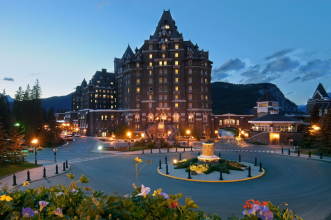
-The Fairmont Banff Springs, formerly and commonly known as the Banff Springs Hotel, is a historic hotel located in Banff, Alberta, Canada. The entire town including the hotel, is situated in Banff National Park, a national park managed by Parks Canada. The hotel overlooks a valley towards Mount Rundle, both of which are situated within the Rocky Mountain mountain range. The hotel is located at an altitude of 1,414 metres (4,639 ft).
-The hotel opened in 1888 by the Canadian Pacific Railway, as one of the earliest of Canada's grand railway hotels. The hotel property has undergone several stages of growth and redevelopment. The original hotel structure was designed by Bruce Price, with another structure completed in 1914. In 1926, a fire destroyed the original structure on the hotel property, although a replacement structure was later completed in 1928. The building was designated as a National Historic Site of Canada in 1988. The hotel property is presently managed by Fairmont Hotels and Resorts.
-The Banff Springs Hotel sits at 405 Spray Avenue near the southern boundary of Banff, a resort town within Banff National Park. The hotel property is bounded by roadways and natural waterways. Two roadways bound the hotel to the north, Bow River Avenue, and Rundle River Avenue, while Spray Avenue bounds the hotel from the west. To the east, the hotel property is bounded by the Spray River. The river serves as a tributary for the Bow River, a waterway north of the hotel property. The hotel property sits near the confluence of the two rivers.
-The town of Banff is located within the Rocky Mountains mountain range, situated 1,414 metres (4,639 ft) above sea level. The community itself is built around Tunnel Mountain. The hotel property looks over across the valley towards Mount Rundle. Other mountain peaks located near the hotel include Cascade Mountain, Mount Norquay, Stoney Squaw Mountain, and Sulphur Mountain. Given its location within a national park, the hotel is located near a number of attractions and natural landmarks. North of the hotel on the Bow River lies Bow Falls. The Banff Upper Hot Springs is a commercially developed hot spring located south of the hotel.
-Booking Website: https://www.booking.com/hotel/ca/fairmont-banff-srpings.en-gb.html?aid=356980;label=gog235jc-1DCAsoJ0IWZmFpcm1vbnQtYmFuZmYtc3JwaW5nc0gzWANoJ4gBAZgBCbgBB8gBDNgBA-gBAYgCAagCA7gCl67R9gXAAgHSAiQ2NzA4Mzg0NS0wOTg4LTQ1MmYtYjZlYS02ZTk0N2QzMGVkNDXYAgTgAgE;sid=ff75cb5577799884d1c86afaf4779498;dist=0&keep_landing=1&sb_price_type=total&type=total&
2.Cave and Basin National Historic Site
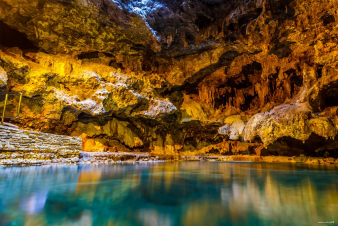
-The Cave and Basin National Historic Site of Canada is located in the town of Banff, Alberta, within the Canadian Rocky Mountains, at the site of natural thermal mineral springs around which Canada's first national park, Banff National Park, was established.
-The Cave and Basin is the lowest component of nine sulphurous hot springs clustered in three groups on the northeast flank of Sulphur Mountain. All are located along the Sulphur Mountain Thrust Fault below Devonian limestones. The water is heated geothermally from an estimated depth of three kilometres. The Cave and Basin is the only cavern large enough to comfortably accommodate groups of people.
-Human habitation in this area can be traced back to 10,700 years BP with the retreat of the last great glaciation, and it is unlikely that the hot springs escaped being noticed. The first recorded reference to hot springs here is by James Hector of the Palliser Expedition in 1859, followed by Joe Healey in 1874 who found the Cave and Basin site in 1875. But it was Canadian Pacific Railway workers William McCardell and Frank McCabe who brought national attention to the Cave and Basin. In 1883 they descended through the skylight entrance into the cave using a felled tree, and the following year constructed a small cabin nearby with the intention of commercializing the Cave and Basin site. Conflicting claims by other parties prompted intervention by the Canadian government headed by John A. Macdonald, and in 1885 an order-in-council reserved 10 square miles (26 km2) around the Cave and Basin, the Banff Hot Springs Reserve. This was the genesis of Canada's national parks system. In 1886 the Canadian government held an inquiry into the various private claims to settle on compensation.
-In 1886 an artificial tunnel was driven into the Cave and Basin to aid visitation. In 1912 bottled water from the Cave and Basin site was sold for its alleged curative powers. In 1914 a naturally heated swimming pool was opened to the public and continued to operate until 1994.
-The Cave and Basin was formally declared a national historic site in 1981. Canada's national parks system celebrated its centennial in 1985, on the anniversary of the order-in-council that established the original reserve around the Cave and Basin.
-Address: 311 Cave Ave, Banff, AB T1L 1K2
-Phone: (403) 762-1566
-Website: https://www.pc.gc.ca/en/lhn-nhs/ab/caveandbasin
3.Mt Norquay
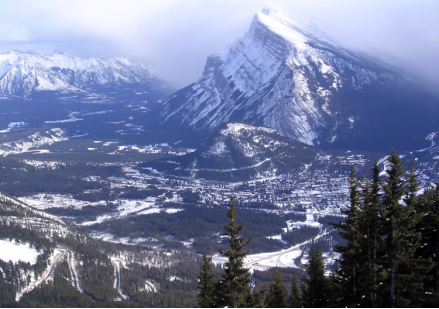
-Mt. Norquay is a mountain and ski resort in Banff National Park, Canada that lies directly northwest of the Town of Banff. The regular ski season starts early December and ends mid-April. Mount Norquay is one of three major ski resorts located in the Banff National Park.
-The mountain was named in 1904 after John Norquay, premier of Manitoba from 1878 to 1887. Norquay climbed the mountain that now bears his name in 1887 or 1888 but, contrary to some reports, did not actually reach the summit.
-The mountain can be scrambled on the western side but involves a number of difficult steps and some exposure. Ascent is not advised while snow persists on the route.
-The first ski runs date as far back as 1926, with the opening of the ski lodge in 1929. Rope tows were installed in 1942 and the mountain was the second in Canada to install a chairlift in 1948 (Red Mountain Resort was the first, in 1947), with a vertical drop of 1,400 feet (425 m). Norquay offered three regular big vertical daily awards in the form of a pin for 25,000 feet for a bronze, 30,000 for silver and 35,000 for a gold, that regulars and staffers have collected over the years. In 1978–79 they also had 50 copies of the platinum 50,000 feet as a celebration of 50 years of the clubhouse at Norquay. Since 1978 Ski Norquay has partnered with Ski Banff, Lake Louise, Sunshine to promote its activities. This created a joined up tri-area lift pass system, which includes shuttle bus transport to and from the resort.
-In 1991, Giant slalom and slalom were held in the resort for the 1991 Winter Deaflympics.
-Since October 2006, the Mount Norquay ski resort has been owned by a group of Alberta-based investors. This ownership group consists of Ken Read, a former Olympic and World Cup Olympic alpine ski racer; Len, Peter, and Robert Sudermann of Fortune Resorts; and Stephen Ross of Devonian Properties in Canmore.
-Address: #2 Mt Norquay Rd, Banff, AB T1L 1B4
-Night skiing: Friday and Saturdays 5-9pm (January 7th – February 25th)
-Phone: (403) 762-4421
-Website: https://banffnorquay.com/
VI.History
-Banff was first settled in the 1880s, after the transcontinental railway was built through the Bow Valley. In 1883, three Canadian Pacific Railway workers stumbled upon a series of natural hot springs on the side of Sulphur Mountain. In 1885, Canada established a federal reserve of 26 km2 (10 sq mi) around the Cave and Basin hot springs, and began promoting the area as an international resort and spa as a way to support the new railway. In 1887, the reserve area was increased to 673 km2 (260 sq mi) and named "Rocky Mountain Park". This was the beginning of Canada's National Park system.
-The area was named Banff in 1884 by George Stephen, president of the Canadian Pacific Railway, recalling his birthplace in Banff, Scotland. The Canadian Pacific built a series of grand hotels along the rail line and advertised the Banff Springs Hotel as an international tourist resort.
-The Banff townsite was developed near the railway station as a service centre for tourists visiting the park. It was administered by the Government of Canada's national parks system until 1990 when the Town of Banff became the only incorporated municipality within a Canadian national park.
-An Internment camp was set up at Banff and Castle Mountain in Dominion Park from July 1915 to July 1917. The prisoners of the internment camp were used as free labour to build the infrastructure of the national park.
-In 1985, the United Nations declared Banff National Park, as one of the Canadian Rocky Mountain Parks, a World Heritage Site. Banff remains one of the most popular tourist destinations in Canada.
-One of the most notable figures of Banff was Norman Luxton, who was known as "Mr. Banff". He published the Crag and Canyon newspaper, built the King Edward Hotel and the Lux Theatre, and founded the Sign of the Goat Curio Shop, which led to the development of the Luxton Museum of Plains Indians, now the Buffalo Nations Museum. He and his family helped organize the Banff Indian Days and the Banff Winter Carnival.
-In 1976, the International Astronomical Union's Working Group for Planetary System Nomenclature (IAU/WGPSN) officially adopted the name Banff for a crater on Mars, after the town in Alberta. The crater is at latitude 17.7° north and longitude 30.8° west. Its diameter is 5 km (3.1 mi).
-In 1991, Banff hosted the 1991 Winter Deaflympics, the first Deaflympics hosted in Canada, and the only Deaflympics held in Canada since then.
VII.Other information
-Infrastructure
-Economic Prosperity Steering Committee consultations note that the Town of Banff could improve and further facilitate key partnerships and collaborations. Examples of potential partnerships included cooperation with Parks Canada, local and regional businesses, and regional municipal partners. The Town of Banff’s community plan stresses the need for cooperation with partners on a number of initiatives including: maximizing resources and infrastructure available for community use, preserving historic sites in Banff, undertaking a long range economic development and retail strategy for the Town and a joint commercial strategy for the Bow Valley. It is well known within the tourism industry that regional partnering can help strengthen tourism development organizations. Partnerships enable sharing of marketing costs and sharing in the wider economic benefits of visitors to the area. Involvement of surrounding municipalities in city initiatives, strategic plans and consultations may also prove to have a similar effect in the strategic initiatives identified above.
-In order to preserve and maintain private sector assets in accordance with consultation findings, and encourage appropriate levels of private sector infrastructure investment, it is recommended that the Town, together with key national partners, implement stricter standards and measures to maintain hotel assets, other accommodations, etc. to a higher level of quality.
-Website: https://banff.ca/DocumentCenter/View/2094/Economic-Prosperity-Strategy?bidId=
VIII.Contact information
-Government
Governing body: Banff Town Council
Mayor: Karen Sorensen
-Town of Banff
110 Bear Street
Box 1260
Banff, Alberta, Canada
T1L 1A1
-Hours: 8:30 a.m. to 4:30 p.m.
-Phone: 403.762.1200
-Fax: 403.762.1260
-Website: https://banff.ca/
